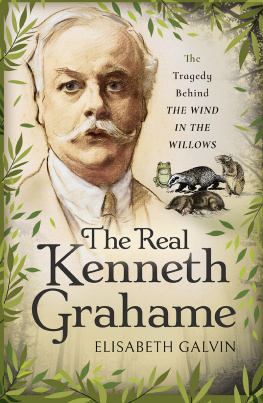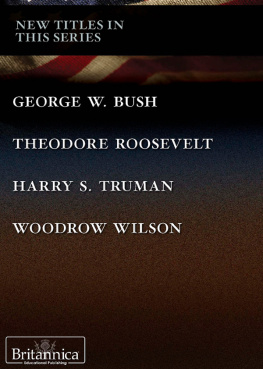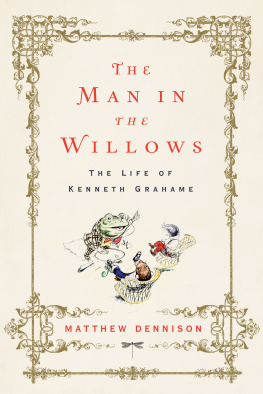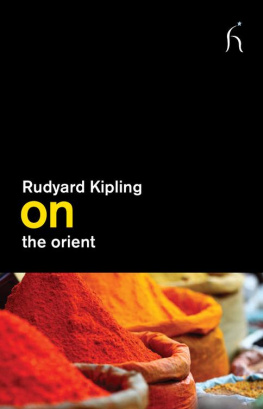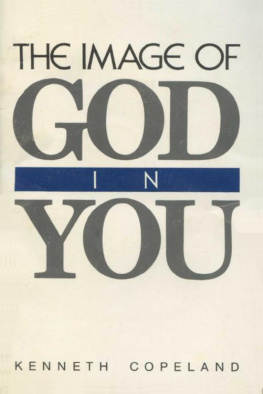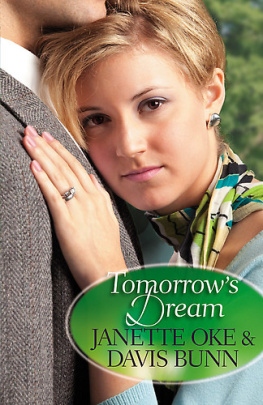Pagebreaks of the print version

The Real Kenneth Grahame
The Real Kenneth Grahame
The Tragedy Behind
The Wind in the Willows
Elisabeth Galvin
First published in Great Britain in 2021 by
White Owl
An imprint of
Pen & Sword Books Ltd
Yorkshire Philadelphia
Copyright Elisabeth Galvin 2021
ISBN 978 1 52674 880 5
eISBN 978 1 52674 881 2
The right of Elisabeth Galvin to be identified as Author of this work has been asserted by her in accordance with the Copyright, Designs and Patents Act 1988.
A CIP catalogue record for this book is available from the British Library.
All rights reserved. No part of this book may be reproduced or transmitted in any form or by any means, electronic or mechanical including photocopying, recording or by any information storage and retrieval system, without permission from the Publisher in writing.
Pen & Sword Books Limited incorporates the imprints of Atlas, Archaeology, Aviation, Discovery, Family History, Fiction, History, Maritime, Military, Military Classics, Politics, Select, Transport, True Crime, Air World, Frontline Publishing, Leo Cooper, Remember When, Seaforth Publishing, The Praetorian Press, Wharncliffe Local History, Wharncliffe Transport, Wharncliffe True Crime and White Owl.
For a complete list of Pen & Sword titles please contact
PEN & SWORD BOOKS LIMITED 47
Church Street, Barnsley, South Yorkshire, S70 2AS, England
E-mail:
Website: www.pen-and-sword.co.uk
Or
PEN AND SWORD BOOKS
1950 Lawrence Rd, Havertown, PA 19083, USA
E-mail:
Website: www.penandswordbooks.com
For my parents
List of Illustrations
Kenneth on his first day at school, aged 9. ( St Edwards School )
Kenneth, centre, with his schoolmates in 1870, looking unenthusiastic with head resting on hand. He sits at the feet of Reverend Algernon Simeon, St Edwards charismatic headmaster. ( St Edwards School )
Inside the Bank of England where Kenneth was employed as a paleface quilldriver. ( The Bank of England Archive )
The magnificent Frederick James Furnivall, who taught Kenneth how to row on the Thames. ( Mary Evans )
Kenneths favourite holiday destination of Fowey in Cornwall, where he visited all his life. ( Mark Camp )
WE Henley, the editor who gave Kenneth his big break. I should be a pig if I ever forgot him, said Kenneth. ( Mary Evans )
Evelyn Sharp (holding placard), editor of Votes for Women and Kenneths early love interest. ( Mary Evans )
Elspeth Grahame aged 19. Many men fell for her beauty and charm including Mark Twain and Alfred, Lord Tennyson. ( National Trust Images )
This poem of Elsies shows her heartbreak at Kenneths coldness at the start of their marriage. ( Bodleian Library, University of Oxford )
Dandyish portrait of W Graham Robertson aged 28 by John Singer Sargent: he was naked under the coat to make him appear slimmer. ( Tate )
Mouse as a young child. Kenneth joked about his hyacinthine locks. ( The Dorneywood Trust )
Mouse by the windmill at Littlehampton, aged seven. This picture was discovered in an old photo album discarded behind the squash court at Dorneywood. ( Private collection )
Woodhall Spa in Lincolnshire, where Elsie tried numerous times to recover from depression. ( Woodhall Spa Cottage Museum, taken from Nicholas M Duke Coxs book Taking the Waters at Woodhall Spa )
Have you heard about the Toad? The first letter Kenneth wrote to his son about the story that became The Wind in the Willows . ( Bodleian Library, University of Oxford )
Mayfield, where Kenneth wrote The Wind in the Willows from the study to the upper right of the front door. ( With thanks to Herries School )
The willows are as beautiful as ever on the Thames at Pangbourne where illustrator EH Shepard spent an afternoon on the riverbank to inspire him for his The Wind in the Willows commission.
The River Lerryn in Cornwall. Could this stretch of water be the one in Kenneths most famous book rather than the Thames? ( Mark Camp )
The day Kenneth was shot at whilst at work made for an amusing cartoon in Punch. ( Mary Evans )
St Fimbarrus Church in Fowey where Kenneth married Elsie in her white muslin day dress. ( Barbara Woodward )
EH Shepards iconic illustrations have endeared readers of The Wind in the Willows for all time. But he made a mistake in this image, depicting Rat rowing instead of Mole.
Coldtonguecoldhamcoldbeefpicklegherkinsaladfrenchrollscresssand wichespottedmeatgingerbeerlemonadeandsodawater.
The ineffable Constance Smedley, original champion of The Wind in the Willows . ( Mary Evans )
I have never read anything of yours yet that I havent enjoyed to the full, wrote President Roosevelt. ( Bodleian Library, University of Oxford )
A true romantic, Elsie wrote valentine cards each year but never received one from the one she loved the most, Kenneth. ( Bodleian Library, University of Oxford )
Bohams, the Grahames beloved farmhouse in the English countryside.
Mouse as an undergraduate of Christ Church College, Oxford. It was the university his father had always longed for.
Kenneth walks with a cane in 1921. He is recovering from his sons untimely death. ( National Portrait Gallery )
Elspeth in her late sixties, after a lifetime of anxiety and depression. ( The Dorneywood Trust )
Kenneth, on his retirement from the Bank of England: his relaxed pose hides the drama of his resignation. ( Mary Evans )
Pretty Church Cottage in Pangbourne, Kenneths final home, which is within walking distance of the Thames.
Acknowledgements
L ike many authors, I began writing a book by reading. I will always be thankful to my eldest daughter Mary for sitting patiently for hours while I read and re-read The Wind in the Willows to her. Everyone I contacted as part of my research was incredibly helpful and no one declined my requests, which indicates the fondness in which Kenneth Grahame is held by so many. David Gooderson has been deeply supportive by very generously sharing his invaluable insights and research about the Grahame family and writing the fine foreword. I am so grateful to the distinguished expert on childrens literature, Professor Peter Hunt, for his wise counsel and encouragement. With indebted thanks to Oliver House and the staff at the Bodleian Libraries Special Collections without whose help this book could not have been written. Similarly, Rachael Muir, assistant archivist at the Bank of England Archives, worked extremely hard to help me. Tim Price, Gemma Kirk-Stretton, Carole Ambrose and the staff at Dorneywood went to great lengths during difficult circumstances of Covid to assist me with my research, which I am truly thankful for. Id like to make a special acknowledgement to Julian Fellowes for his time and astute points and Alex Bloch for arranging our interview. I am also much obliged to Gaynor Haliday, Laura Hirst and Aileen Pringle at Pen & Sword; Chris Nathan, archivist at St Edwards School with his colleague Tracy van der Heiden; Fiona Long, headmistress of Herries Preparatory School; Robert Athol, college archivist of Jesus College, Cambridge; Yale University Library; Weston Library, Connecticut; Furnivall Sculling Club in Hammersmith; The River and Rowing Museum in Henley; and St Annes Church, Dropmore. I greatly appreciate those who helped me in Cornwall including: Barbara Woodward for her fine photographs of Fowey; Sue Reardon; Mark Camp of Visit Cornwall and Walkaboutwest; Royal Fowey Yacht Club; and Fowey Hall Hotel. With grateful thanks to the Woodhall Spa Heritage Committee and Patricia and Nicholas Duke-Cox of Woodhall Spa Cottage Museum for generously sharing their research, knowledge and photographs. I would especially like to thank Richard and Valerie Caesar of Church Cottage for all their kindness. Most importantly I acknowledge the love and support of my family and friends, including my parents Bert and Gay Attwood and my sister Hayley Relph for reading the manuscript, Dr Emma Baldock for so thoughtfully sharing her perceptive psychological insights, Tatiana Morales for donating hours of her time carefully editing the manuscript, and Dale Mulholland and Paul Brogan for their perceptive feedback. Finally, with love and thanks to Sarah Woozley, Miriam Fenster and Linda Mandel, who gave me permission to swim in their beautiful river during Covid, which helped me keep alive the spirit of the Thames as I slowly wrote my way through lockdown.

